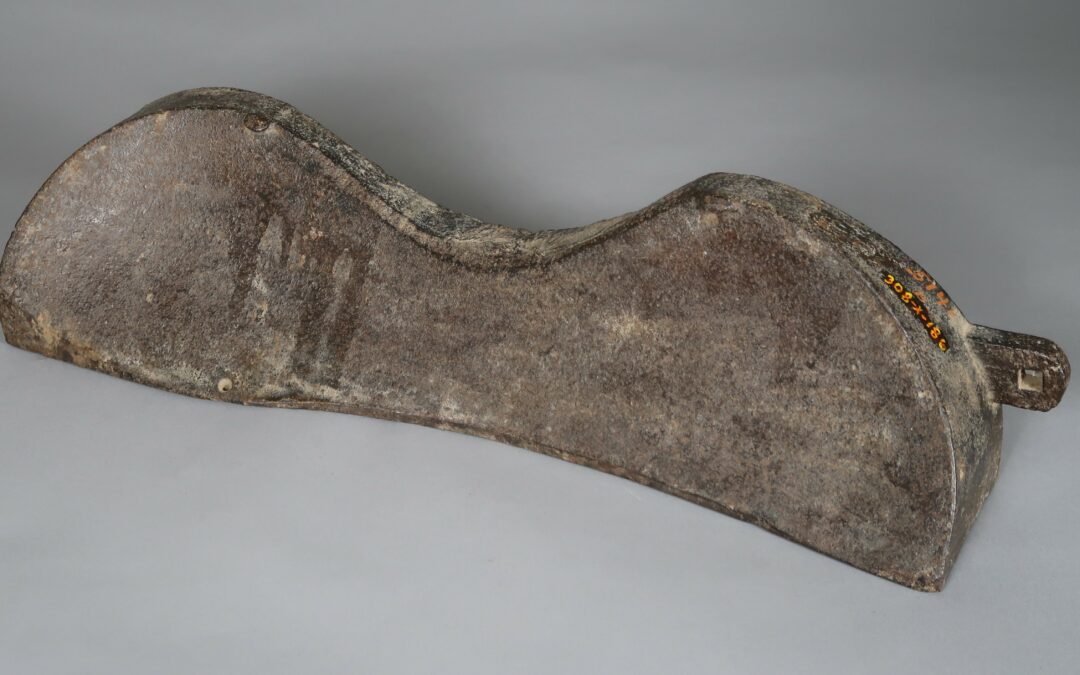Some of the earliest industries in Sacramento involved crafting tools and equipment for horses and other large livestock.
Stephen Hite was one of the first saddle makers in Sacramento. He originally came to California to mine gold but found little success in Placerville. By 1852, Hite had moved to Sacramento and opened a harness and saddle making shop. According to an 1858 article in the Sacramento Daily Union, Hite employed 3 to 4 men and manufactured between 1,500 and 2,000 saddle trees annually.[1]
Saddle trees, typically made of wood, created the base structure and design for a leather saddle. Saddle trees therefore had a crucial role in saddle making since they determined the fit to the horse, balance of the rider, and overall strength and longevity of the saddle.
The saddle form pictured below was owned by Stephen Hite and is in the Sutter’s Fort collection. It remains a mystery despite the research efforts of the State Parks curatorial team!
It is the same shape as a saddle tree, yet it is made of solid iron while saddle trees are typically constructed out of wood. Our best guess is that Hite and his workers used the iron saddle form as a mold for the production of wooden saddle trees.
If you have knowledge on saddle construction and can help us identify this piece, please contact Curator Emma Silverman at emma.silverman@parks.ca.gov.
About the “Inside Sutter’s Fort, Museum Collection Spotlight Series”
We’re excited to introduce you to a brand-new email series that will transport you back in time and immerse you in the rich tapestry of California’s past. Welcome to the “Inside Sutter’s Fort, Museum Collection Spotlight Series”! As the nonprofit partner for Sutter’s Fort State Historic Park, Friends of Sutter’s Fort works to support our partners at California State Parks as they care for the historic buildings and artifacts at Sutter’s Fort.
The Sutter’s Fort Collection of artifacts, images and ephemera is fascinating, and we wanted to create a new way to share them with you. The Museum Collection Spotlight series will be co-authored by Emma Silverman (Cultural Resources Program Manager), Judy Russo (Museum Technician), and Morgan Braun (Park Interpretive Specialist), based in part on research files assembled by State Park curators over decades.
We are delighted to share this new monthly email series to give insights on items from the Sutter’s Fort Collection and the ongoing work preserving, identifying and researching collection items. This email series is our way of bringing the museum’s treasures right to your inbox. Each month, you’ll receive an email that opens a window into this curated collection, revealing one extraordinary artifact at a time. We hope you enjoy this email series!
Overview of Sutter’s Fort State Historic Park Collection
The Sutter’s Fort State Historic Park Collection is one of the largest in the State Park system, with over 50,000 objects including photographs, diaries, letters, maps, paintings, furnishings, tools, and housewares. The Collection contains items that directly testify to life at Sutter’s Fort in the 1840s such as John Sutter’s magnifying glass, likely used to inspect the nugget that sparked the Gold Rush, and a Spanish-style plow used by Native people who were forced to labor for Sutter. However, the bulk of the collection, traditionally known as the “Pioneer Collection,” was amassed in the first part of the twentieth century and represents the experiences of Euro-American settlers and the history of the formation of the State of California.
While there are many artifacts typically on display at the historic site, most items from the Sutter’s Fort collection are housed at a state of the art curatorial facility on the former McClellan Air Fort Base. This facility is called the Statewide Museum Collections Center (“SMCC”). The talented California State Parks Curatorial team cares not only for the exhibits at the Fort, but for this huge collection offsite.
A special Thanks to the Authors of this Series
Collections Highlights from September 2023 to March 2024 are co-authored by Emma Silverman (Cultural Resources Program Manager), Judy Russo (Museum Technician), and Morgan Braun (Park Interpretive Specialist), based in part on research files assembled by State Park curators over decades.
Meet the Curator
Emma Silverman holds a PhD in American Art History from UC Berkeley. After several years as a visiting professor at Smith College and Sacramento State University, she served as a Mellon Humanities Postdoctoral Fellow with the National Park Service—and fell in love with working for public parks! In January of 2023, Emma started her position as Cultural Resources Program Manager for California State Parks Capital District. Emma has enjoyed getting to know the incredible museums and historic sites in Sacramento and working towards the goal of making State Park collections more accessible to the public. She can be reached at emma.silverman@parks.ca.gov..

